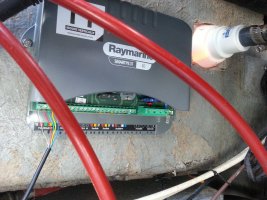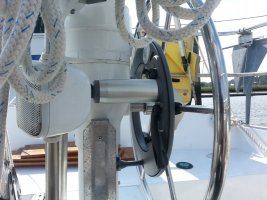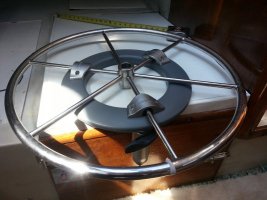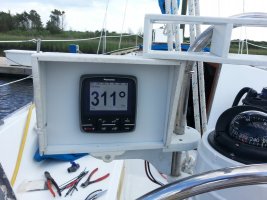fgmjrmorton
Junior Member
Hi all,
I need some advice! I am in the planning process for installation of a Raymarine SPX-5 Wheel Autopilot with P70 control head. In poking around, I can't for the life of me figure out how to get the wiring from one place to another. The electrical panel is located on the port side of the companionway above the icebox. Lacking a dedicated navigation area, about the only "good" place I can see to locate the autopilot computer is on the starboard side above the aft berth (on the wire race cover?).
In addition to getting wiring from the breaker panel to the starboard side, I need to get all of the wires from the pedestal guard, mounted on the bridge deck, to the site of the computer. I've looked at Christian Williams' blog regarding his installation several times, and except for the need to be a contortionist with exceptionally long arms, I didn't see any direction about where to lead the wiring.
I've thought about mounting a terminal block, a ground buss, and maybe a small fuse block behind the computer for computer power, GPS and NMEA 0183 wiring. Will I be able to use a single breaker switch at the electrical panel for both the autopilot and the control head? I have no spare breakers on the panel and will probably need to take something off and replace it with the autopilot. Either that or mount a separate small panel specifically for the autopilot. According to the information supplied with the Raymarine equipment, the fusing requirement for the computer is 15 amps (built-in) and for the control head 5 amps. Did you use a single breaker switch for both Christian? Another question I have is; where did you ground the autopilot computer?
Thanks in advance for any assistance!
Smooth sailing.
Fred
I need some advice! I am in the planning process for installation of a Raymarine SPX-5 Wheel Autopilot with P70 control head. In poking around, I can't for the life of me figure out how to get the wiring from one place to another. The electrical panel is located on the port side of the companionway above the icebox. Lacking a dedicated navigation area, about the only "good" place I can see to locate the autopilot computer is on the starboard side above the aft berth (on the wire race cover?).
In addition to getting wiring from the breaker panel to the starboard side, I need to get all of the wires from the pedestal guard, mounted on the bridge deck, to the site of the computer. I've looked at Christian Williams' blog regarding his installation several times, and except for the need to be a contortionist with exceptionally long arms, I didn't see any direction about where to lead the wiring.
I've thought about mounting a terminal block, a ground buss, and maybe a small fuse block behind the computer for computer power, GPS and NMEA 0183 wiring. Will I be able to use a single breaker switch at the electrical panel for both the autopilot and the control head? I have no spare breakers on the panel and will probably need to take something off and replace it with the autopilot. Either that or mount a separate small panel specifically for the autopilot. According to the information supplied with the Raymarine equipment, the fusing requirement for the computer is 15 amps (built-in) and for the control head 5 amps. Did you use a single breaker switch for both Christian? Another question I have is; where did you ground the autopilot computer?
Thanks in advance for any assistance!
Smooth sailing.
Fred




